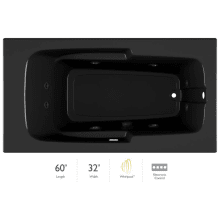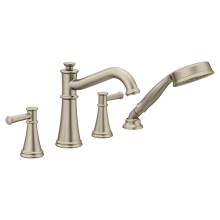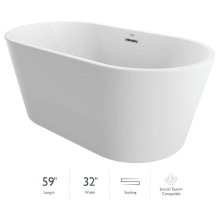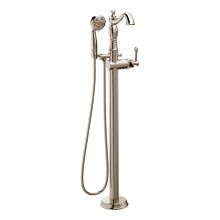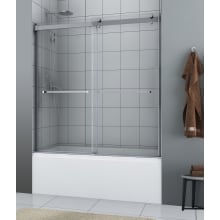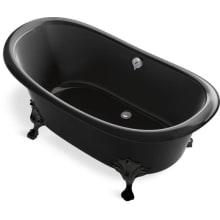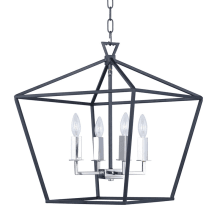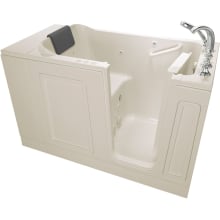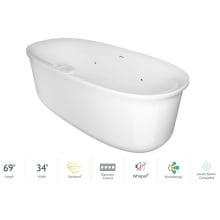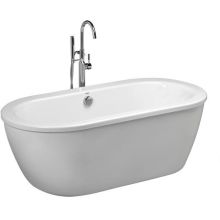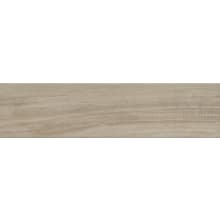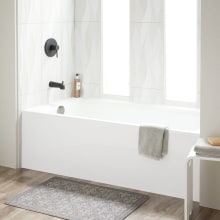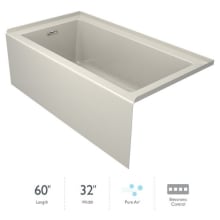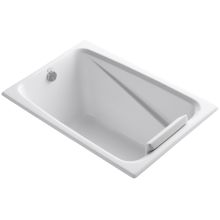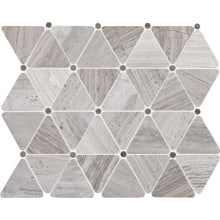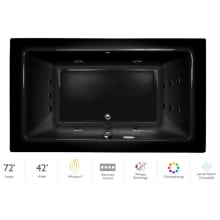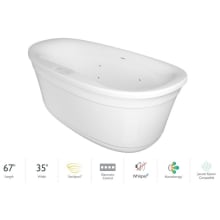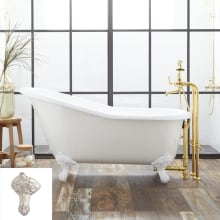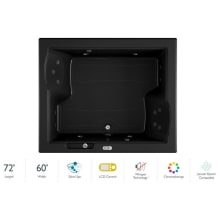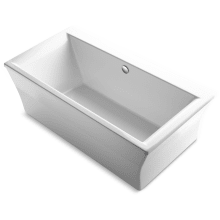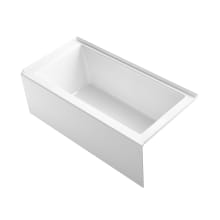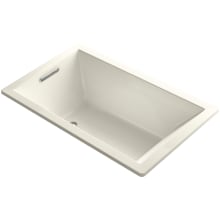Types of Bathtubs
The bathtub type sets the style and comfort of your entire bathroom experience so here’s how to find the right one.
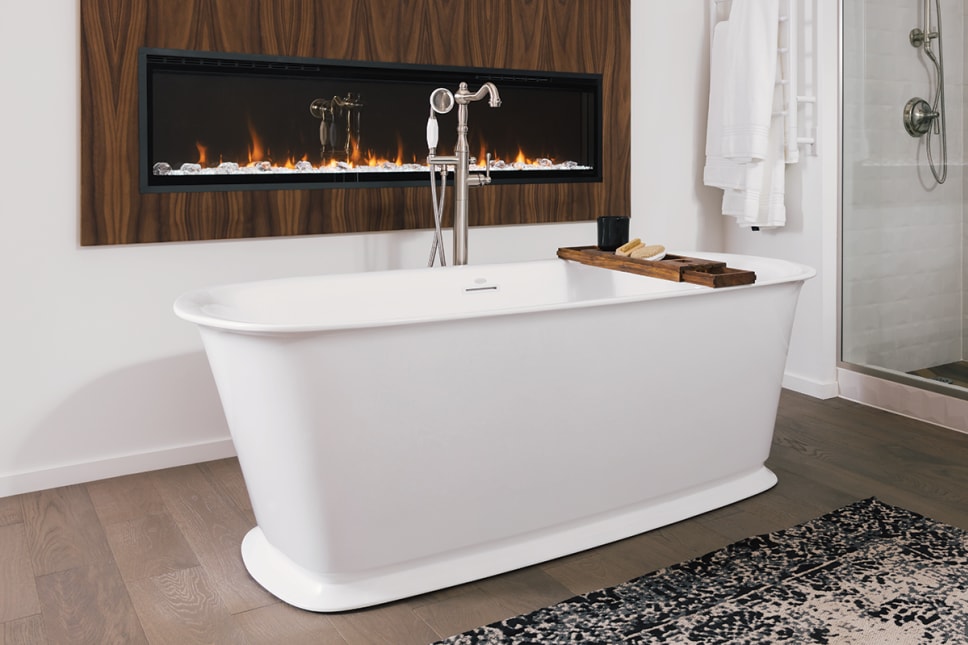
Finding the perfect bathtub means first knowing the different types of bathtubs out there to choose from. Once you know what’s available, it’s easy to make the choice that is best for your bathroom remodel. There are many features, from bathtub shapes to the tub options and materials, that need to be considered before you buy a tub.
For this bathtub buying guide, we broke down the different types of bathtubs for you so you can feel confident in your home improvement investment when it comes to buying the best type of tub for your bathroom.
How to Choose a Bathtub Type
It’s important to know the different names of bathtubs so you know what style you prefer, but there are other key considerations when planning for bathtub updates. Between the cost of the tub to the installation, you want to be sure you choose the best fit for your home. If you’re wondering what is the best type of bathtub to get, here are a few things to keep in mind as you browse:
The Overall Bath Experience

Because it influences the look of the bathroom itself, the look of the bathtub design is an obvious essential factor in your choice of bathtub type. Tubs don’t all look the same or take up the same visual space. Find a tub you like that completes the whole look and design of the room.
Creating the perfect home bath experience also requires finding a tub that does what you want it to do. Will it be used for a relaxing, full-body soak? Or is the usual daily routine centered around the shower? Plan for the routine you have as well as the one you want, so make sure to look for the options you know you will use. Not all bathtub options will be a fit for shower features, and some types of bathtubs have specific space or design features that must be built in to be used most effectively.
The Ideal Bathtub Size

There are many different sizes of bathtubs to choose from. It’s a good idea to be clear on the interior dimensions of the tub so you can be sure the tub will perform the tasks your household expects of it.That could mean a tub for a quick shower or a long soak, and anything in between, which means having an idea how much space may be needed for water before the overflow drain inside the tub empties the bath.
Part of that consideration, of course, is whether or not the tub will fit in the available space of your bathroom layout. The exterior dimensions of the bathtub will influence the tub’s physical footprint in your bathroom. Make sure you know the floor plan measurements will fit the exterior dimensions of the bathtub.
As a general bathtub size guide, a standard tub is usually 60” long, 30” wide, and 14” to 16” tall, with a soaking depth of no more than 12” high. They can be ideal when used for combination bath and shower spaces, while it might not be as comfortable when used for soaking.
Types of Bathtub Materials
The best quality bathtubs will be made from the best quality materials, regardless of the style. Before you decide between standard tubs or freestanding bathtubs, make sure you know what the tubs are made from. The different characteristics of the materials may make a big impact on the life of the tub.

For instance, if the family’s favorite canine will be in the tub for the occasional clean up between grooming appointments, the tub needs a sturdy interior finish to handle the scratch of the dog claws. Some materials are easier to keep clean than others, too. Look around for the best bathtub materials for your household.
Must-have Bathtub Extras

The classic design of the bathtub has evolved over the years. Now a simple soak in a tub can be a relaxing experience complete with targeted jets to work out tight muscles, and even music to soothe and clear the mind. Look for these bathtub benefits before you consider the types of bathtubs for your home.
- Bluetooth speakers - When you’re in the mood for music, or listening to an audiobook or podcast, some newer tubs are designed to allow you to synch your phone, tablet, or smart home device to the built-in speakers in the tub shell.
- Chromatherapy - Popular with air tubs and whirlpools, as well as soaking tubs, chromatherapy features allow the user to light up the water with mood-enhancing LED lights.
- Digital Controls - Different models will offer the ability to control the tub’s features with an onboard, easy to use, waterproof control panel. Some may also include a remote control option.
- Shell shape - Whatever the additional shape or features, a tub can be designed with a built in seat, or a flat floor surface, some even offer a textured, non-slip surface. A bathtub may have an angled floor with a gradual slope toward the drain to help with draining the water, or to offer a more steady walking surface. Other tubs have one or both ends angled to provide back support or armrests.
- Therapeutic water movements - Whether whirlpool jets for targeted massage, or air for more gentle results, many tubs feature customizable jets and bubbles to improve the soaking experience.

Other key benefits offered by the different types of bathtubs include the accessibility of the design itself. If the household has members with mobility limitations, or maybe you’re updating with an eye toward aging in place at home, look for tubs that have been certified compliant with ADA standards. These tubs offer a variety of features, from textured floor and seat surfaces, to the height and width requirements that are there to help ensure the safest and most comfortable user experience.
A final word of advice when choosing between types of bathtubs for your home is to make sure the tub includes a warranty. A bathroom remodel with a new tab can be a hefty investment, and the tub warranty offers peace of mind that you will enjoy the tub update for years to come.
Bathtub Installation Requirements
Before you choose the type of bathtub for your bathroom remodel, plan ahead for the installation challenges that will arise. Of primary importance is whether or not the tub will fit into the bathroom itself.
As part of the layout and size considerations, take into account the drain location on the bathtub design. These will be left, right, center, or reversible drains. The tub drain must line up with the plumbing layout of the bathroom, unless you plan on doing a custom renovation, so choose the correct drain location.

The drain location is determined by facing the tub from the front, such as the skirted side of an alcove tub, and noting which side the drain is on.
- If the front of the tub lines up with the drain on the left, then it is a left handed drain.
- If the drain is on the right side, it is a right handed drain.
- If the drain is located in the center, it is a center drain tub.
A reversible drain tub will not have a designated ‘front’ side, such as a drop-in tub, which can be arranged however the deck platform is designed to hold it, so the drain placement can be arranged however it best fits with the plumbing.
If you are adding a bathtub to a new build, the dimensions aren’t as much of a factor when the tub can be moved around in spaces that don’t yet have walls or finished doorways. For a remodel, the tub will have to be carried from the delivery point to the bathroom, which means fitting it between door frames, hallways, and possibly even over stairs. Make sure the tub dimensions are such that the tub will fit around all of these obstacles.

Similarly, pay attention to the condition and durability of the bathroom flooring. The tub itself is generally heavy, but an installed standard tub can hold between 320 and 480 pounds or more of just water. Between the weight of the tub itself, the water capacity, and the addition of a bather, that’s a lot of weight concentrated in one spot that can add strain to the floor. You want to be sure the floor holds no more than 40 pounds per square foot, whether you choose a standard tub or a soaking tub.
If you’re looking to get a larger tub, or just replacing an existing one, check the floorboards and supporting joists to ensure there’s no rot or other problem spots before installing a new tub. A weak floor can be shored up with new supports, and reinforced with a newer, sturdy layer of floorboard, such as oriented strand board, or OSB.
Finally, before choosing which type of bathtub to purchase, determine whether or not the bathroom has the appropriate electrical supply for the tub features you choose. Some tubs, such as a whirlpool tub or air tub, will require specific electrical access, and that connection point will have to be located close to the tub’s internal controls, such as the motor, under the deck. For instance, if the power source in your bathroom is located on the left side of the room, then look for a tub that will best match that left-handed design.
Types of Bathtubs
There are multiple design styles to choose from when selecting the type of bathtub that is right for your home. The first type to narrow down is what type of installation will best fit your bathroom layout. From there, you can select the type of bath experience you want.
Bathtub Installation Types
The installation type of a tub determines the kind of preparation and work that must be done to fit the tub in the bathroom itself, but it also indicates the look of the tub, or the exterior design, in relation to the rest of the room. Different experience features of the tub can be available across nearly all installation types, so find the installation that works and then get more specific from there.
Alcove tubs

Situated between three walls, the alcove tub allows you to maximize the floor space in most bathrooms by tucking the tub out of the way. Alcove tubs will generally have one front panel, or apron, along the forward edge of the tub, while the three other sides of the tub will be open to make installation easier. The alcove tub may be designed with three wall panels that make up the tub surround to protect the walls, or it may be installed against tiled walls.
A shower curtain or sliding glass door are easily installed to keep the space clean and offer privacy. They are often used with bath/shower combinations and are easy to step in and out of for many people. Grab bars and other safety precautions can be added to the walls to make alcove tubs more accessible for those with limited mobility.
Drop-in tubs

A drop-in tub requires a framework or platform base to be built for the tub to install into. The tubs are designed to utilize an upper rim, or ledge, that sits above the flat surface of the deck surrounding the tub. The deck surround offers extra insulation to keep the bath water warmer longer than with freestanding tubs.
The base is shaped to the size of the tub and the tub is lowered into it when the platform is finished, usually with tile, stone, or wood paneling. Drop-in bathtubs can be found in many different shapes and sizes, from round and oval, to square, or the diamond-shaped corner tub.
Freestanding tubs

A freestanding tub is designed to be installed to the floor, without requiring a support wall or surrounding platform. The faucet, handles, and water drains are all exposed plumbing work above the floor, located outside the body of the tub. Most plumbing fixture designs paired with these tubs are also freestanding rather than mounted into the wall or installed into the tub edge.
Many freestanding bathtubs are double layered and flat-sided to help insulate and keep the water warm. Others are sturdy and creatively designed to match other particular functions, such as tubs that are high-backed or uniquely shaped to create different experiences.

Freestanding designs include:
- Clawfoot tubs - The classic freestanding tub, a clawfoot tub is a deep soaking tub, usually made of sturdy cast iron or porcelain, that rests on four feet, supported off the floor. These tubs are generally larger than other freestanding tubs, can be very heavy, and are just as permanent an installation as any other type of bathtub.
- Japanese soaking tubs - For smaller bathrooms, the luxury of a soaking tub is still available thanks to the smaller footprint of the Japanese soaking tub. These are circular, deep soaking tubs, with either a flat bottom or a built in seat, and they have a diameter of between 40” and 60” to help maximize space in the bathroom layout.
- Pedestal, or skirted tubs - These tubs are lifted, similar to the clawfoot style, but the space under the tub is enclosed in a pedestal that goes all the way around.
- Single ended tubs - One end of the tub is flat-walled and reserved for the drain and faucet, while the other is sloped for the bather to soak.
- Double ended tubs - The ends of these oval-shaped tubs are rounded and extended out to provide a back support for the bather on either end. The faucet and drain are normally installed in the middle.
- Slipper tubs - One end of these tubs are reserved for the faucet and drain, while the other is sloped for more comfortable lounging. A slipper tub has a raised edge on the lounging end to create back, neck, and arm rests for the bather.
- Double slipper tubs - These tubs are designed to be entered from the middle of the bath, as both ends have a raised wall to allow for sloped and supported relaxing on either side. The faucet and drain are located in the middle.
From a freestanding clawfoot to a pedestal soaking tub, a single type of bathtub offers a wide variety of choices in design. Look for the style that suits your space with the features you want.
Undermount tubs

Similar to drop-in tubs, undermount tubs are designed to be built into a platform base that hides the shape of the tub from view. These tubs are supported from beneath the tub rather than disperse any weight over the top of the base, and do not hang from the deck.
Unlike with drop-in tubs, there is no upper rim on the tub shell to overlap the top of the tub surround, as the tub edge is installed under the surface of the platform deck. This creates a flush edge between the tub and deck edge, making it easier to get in and out of the tub, as well as to keep the bath area clean, particularly with a tile or stone deck surround.
As you can see, the installation methods all have an impact on the eventual look of the finished bathroom design. Start by narrowing down the types of bathtubs that fit both the look you want and the space available in your bathroom.
Types of Bathtub Innovations
The modern bath can require a space as shallow as a shower stall or as large and luxurious as a spa or soaking tub, it just depends on the features you choose when you pick the tub. Most of these features can be found in your choice of tub installation type. It’s all a matter of knowing what features to look for.
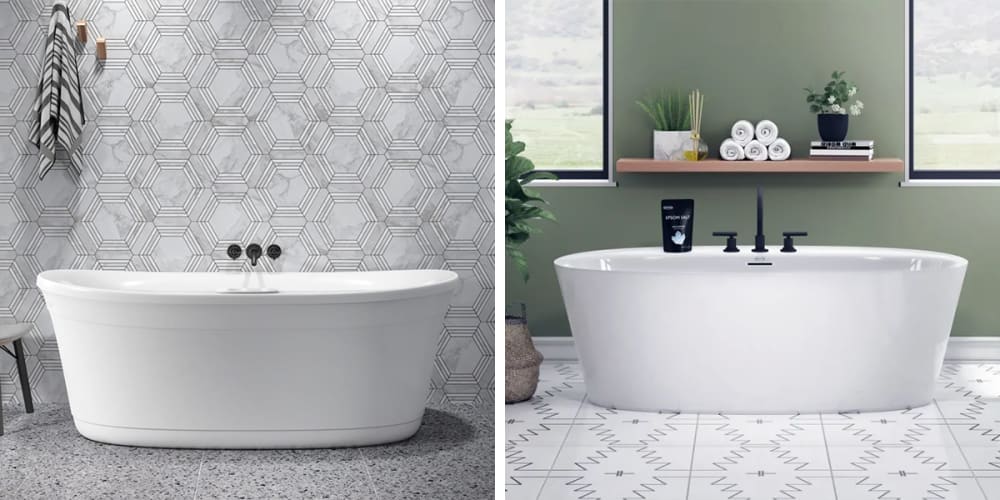
- Air tubs - To create a spa experience at home, many choose the heated air tubs, which are lined with small jets at various points in the tub and are designed to line up with the user’s tension points. They offer a gentle, effervescent massage.
- Combination tubs - A combination tub blends the features of an air tub with a jetted whirlpool tub.
- Soaking tubs - Also known as a garden tub, and includes tub shapes like a clawfoot tub or a Japanese soaking tub, the freestanding soaking tubs are deeper than most to accommodate more water. The primary difference between a soaking tub and a regular, standard sized tub is the water depth. The overflow drain on a soaking tub will be placed higher along the tub wall, allowing a water depth of anywhere between 14 to 22 inches deep. A standard tub, in contrast, is designed to hold only 12 to 14 inches of water. Because they are freestanding tubs, not built into any walls or decks, soaking tubs generally do not have additional features such as air or whirlpool jets.
- Walk-in tubs - A walk-in tub is designed to increase accessibility by allowing a user to step a short distance into the tub and take a seat inside in order to safely enjoy a luxurious bath. These tubs offer a water-tight door seal and include a high water depth to allow a user to soak while sitting upright on a built-in seat or bench. These tubs are great for mother-in-law suites or home remodels.
- Whirlpool tubs - The whirlpool tubs are smaller than a pool, but larger than a standard tub, and built with various hydrotherapeutic features, starting with targeted water jets to help relax specific muscle groups. The speed and pressure of the jets are controlled with deck-mounted control panels or use a remote control. These jets are built in under the tub shell and hidden under the tub deck or surround, to be accessed by side panels for maintenance. The whirlpool tub, like air tubs, will require access to an electrical supply.
Bathtub Materials
The material a tub is made of influences more than just the cost. The material isn’t just for looks either, as many tubs can be painted or finished to match any decor, while other materials offer unique style. What a tub is made of plays a role in the whole bath experience, from the texture of the finish to the temperature of the water.

The materials can include:
- Acrylic
- Cast iron
- Composite
- Copper
- Enameled steel
- Fiberglass
Cultured marble, stone, and solid surface tubs are very similar, made of stone and resin to form the shape of the tub. Specialty materials like wood and glass are being incorporated in bathtub styles more. Insulated tubs will hold in the heat well, but if you don’t choose a tub with a circulating heat system such as some whirlpool tubs, a cast iron or composite tub will warm from the heat of the water and hold it longer.
If the material of the tub is not immediately obvious, such as stone, wood, or glass, then what type of material is it? To find out what kind of tub you have, there are a few easy tests to try.
- Grab a magnet! An enamelled metal tub, such as cast iron or steel, will hold a magnet in place.
- Porcelain tubs are solid and unyielding, with no hollow sound. They will not pass the magnet test though, so if a magnet won’t hold to the side, the tub might be porcelain.
- An acrylic tub has a surface appearance like plastic, and it sounds hollow if you knock your hand on it.
- Fiberglass is similar to acrylic, but there is not as much give when you put pressure on it, such as leaning to stand up.


